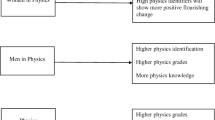Abstract
High-stakes testing (HST) is critical in the educational system of East-Asian countries like China, and the ongoing standards-based reform in many Western countries like the USA. HST has been criticized for corrupting an educational system through means like disengaging students from authentic learning. It seems that students’ affective learning would be promoted if HST were abandoned. In this study, we used the mixed-method approach to investigate this hypothetical question by comparing the physics identity of high-school students in an HST-oriented educational context and college students who have transferred from an HST-oriented context to an almost HST-free one in China. We administered a physics identity survey with 108 students from two physics classes in a key high school and 233 undergraduate physics majors in a top-tier university who were separated by Gaokao as the most life-shaping test in China. We also interviewed sample participants about their physics learning. The data show the freshmen in college had a significantly higher average physics identity than the high-school students did. In the undergraduate physics program, the average physics identity had a deteriorating pattern from the freshmen, sophomores, to juniors. From high school to college, the students’ intention of pursuing physics as a major or career was similarly low. Differently, the students’ perception of lecturing changed, so did their self-discipline. Together, the findings suggested that simply discarding HST would not promote students’ affective learning. An alternative was needed to replace the extrinsic pressure from HST, which could be either students’ intrinsic engine of learning or another rewarding or coercive system.


Similar content being viewed by others
References
American Psychological Association. (1997). Learner-centered psychological principles: a framework for school reform. Retrieved from https://www.cdl.org/articles/learner-centered-psychological-principles/. Accessed July 2018.
Amrein, A. L., & Berliner, D. C. (2002). The testing divide: new research on the intended and unintended impact of high-stakes testing. Peer Review, 5(2), 31–32.
Ary, D., Jacobs, L. C., & Razavieh, A. (2002). Introduction to research in education. Belmont: Wadsworth/Thomson Learning.
Au, W. (2007). High-stakes testing and curricular control: a qualitative metasynthesis. Educational Researcher, 36(5), 258–267.
Berliner, D. (2011). Rational responses to high stakes testing: the case of curriculum narrowing and the harm that follows. Cambridge Journal of Education, 41(3), 287–302.
Carlone, H. B., & Johnson, A. (2007). Understanding the science experiences of successful women of color: science identity as an analytic lens. Journal of Research in Science Teaching, 44(8), 1187–1218.
Deci, E. L., & Ryan, R. M. (2016). Optimizing students’ motivation in the era of testing and pressure: a self-determination theory perspective. In C. W. Liu, K. J. C. Wang, & M. R. Ryan (Eds.), Building autonomous learners: Perspectives from research and practice using self-determination theory (pp. 9–29). Singapore: Springer.
Gunzenhauser, M. G. (2003). High-stakes testing and the default philosophy of education. Theory Into Practice, 42(1), 51–58.
Harlen, W., & Deakin Crick, R. (2003). Testing and motivation for learning. Assessment in Education: Principles, Policy & Practice, 10(2), 169–207.
Hazari, Z., Sonnert, G., Sadler, P. M., & Shanahan, M. C. (2010). Connecting high school physics experiences, outcome expectations, physics identity, and physics career choice: a gender study. Journal of Research in Science Teaching, 47(8), 978–1003.
Hestenes, D., Wells, M., & Swackhamer, G. (1992). Force concept inventory. The Physics Teacher, 30(3), 141–158.
Kirkpatrick, R., & Zang, Y. (2011). The negative influences of exam-oriented education on Chinese high school students: backwash from classroom to child. Language testing in Asia, 1(3), 36.
Liu, Y. (2016). Higher education, meritocracy and inequality in China. Amsterdam: Springer.
McNeil, L. M., Coppola, E., Radigan, J., & Heilig, J. V. (2008). Avoidable losses: high-stakes accountability and the dropout crisis. Education policy analysis archives, 16(3), 1–48.
Muthanna, A., & Sang, G. (2015). Undergraduate Chinese students’ perspectives on Gaokao examination: strengths, weaknesses, and implications. International Journal of Research Studies in Education, 5(2), 3–12.
Osborne, J. (2014). Scientific practices and inquiry in the science classroom. In N. G. Lederman & S. K. Abell (Eds.), Handbook of research on science education (Vol. 2, pp. 579–599). New York: Routledge.
Roderick, M., & Engel, M. (2001). The grasshopper and the ant: motivational responses of low-achieving students to high-stakes testing. Educational Evaluation and Policy Analysis, 23(3), 197–227.
Wang, J., & Hazari, Z. (2018). Promoting high school students’ physics identity through explicit and implicit recognition. Physical Review Physics Education Research, 14(2), 020111.
Wang, J., Hazari, Z., Cass, A. P., & Lock, R. M. (2018). Episodic memories and the longitudinal impact of high school physics on female students’ physics identity. International Journal of Science Education, 40(13), 1543–1566.
Watson, C., Johanson, M., Loder, M., & Dankiw, J. (2014). Effects of high-stakes testing on third through fifth grade students: student voices and concerns for educational leaders. Journal of Organizational Learning and Leadership, 12(1), 1–11.
Wise, S. L., & Kingsbury, G. G. (2016). Modeling student test-taking motivation in the context of an adaptive achievement test. Journal of Educational Measurement, 53(1), 86–105.
Yan, C. (2015). ‘We can’t change much unless the exams change’: teachers’ dilemmas in the curriculum reform in China. Improving Schools, 18(1), 5–19.
Yu, L., & Suen, H. K. (2005). Historical and contemporary exam-driven education fever in China. KEDI Journal of Educational Policy, 2(1), 17–33.
Author information
Authors and Affiliations
Corresponding author
Additional information
Publisher’s Note
Springer Nature remains neutral with regard to jurisdictional claims in published maps and institutional affiliations.
Rights and permissions
About this article
Cite this article
Wang, J., Li, Q. & Luo, Y. Physics Identity of Chinese Students Before and After Gaokao: the Effect of High-Stake Testing. Res Sci Educ 52, 675–689 (2022). https://doi.org/10.1007/s11165-020-09978-y
Accepted:
Published:
Issue Date:
DOI: https://doi.org/10.1007/s11165-020-09978-y




